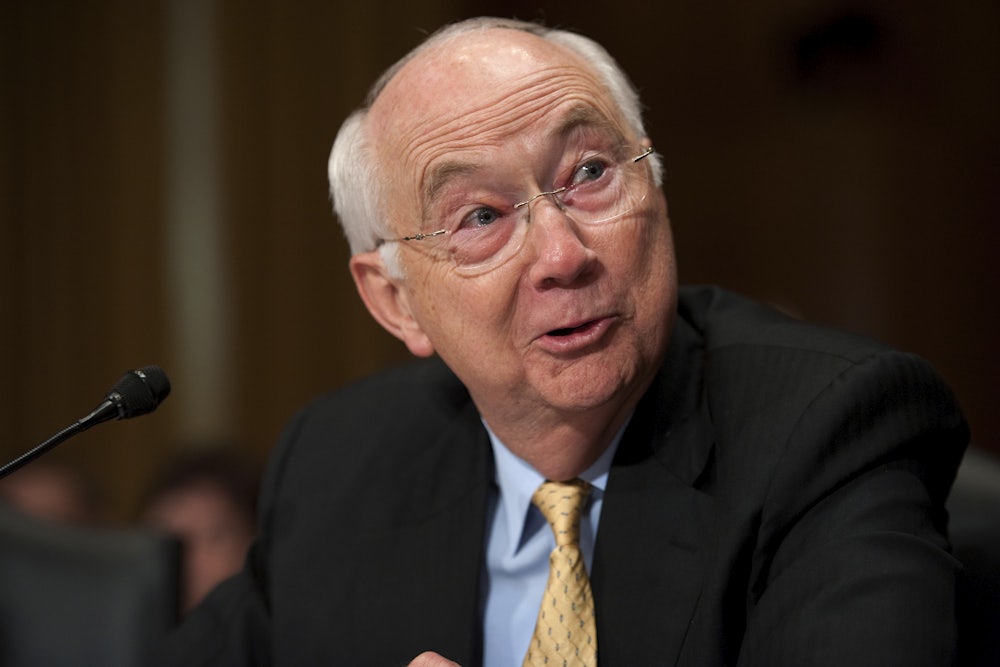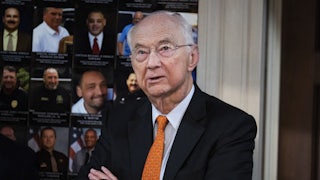If I were to paraphrase Phil Gramm’s analysis of Charles Dickens’s much-loved A Christmas Carol, you wouldn’t believe me. So I’ll have to quote Gramm at length. What follows is from The Myth of American Inequality: How Government Biases Policy Debate, a new book by the former senator and Texas A&M economist, in collaboration with economists Robert Ekelund and John Early. Because I didn’t finish discussing this book Wednesday, I’m writing about it again today. And now to Gramm’s explication de texte:
There is no better illustration of how wealth accumulation benefits society than the most famous and infamous wealth hoarder of Victorian literature, Ebenezer Scrooge.… Scrooge is a caricature of a man of business in the Victorian era: a rich, obsessive wealth hoarder. The very name Scrooge has become a global synonym for stingy or miserly.… Dickens describes Scrooge as working in a “moldy old office” and living in “his dusty chambers” in a building so old and dreary that “nobody lived in it but Scrooge.” He was “a tight-fisted hand at the grindstone.” He strove from dawn till dusk to “understand his own business” and “with his banker’s-book” trudged home in the dark to “take his gruel” alone by a dying fire.
Scrooge may be rich, Gramm is saying, but he doesn’t indulge in vulgar displays of nouvelle richesse like the Real Housewives of Beverly Hills. Let’s continue:
There is nothing unethical about Ebenezer Scrooge. In his view, business “is the even-handed dealing of the world,” and good business fights poverty: “there is nothing on which it is so hard as poverty.” … Dickens never considered the possibility that Scrooge and Marley’s business in any way contributed to the common welfare of humanity.
There is nothing unethical about Ebenezer Scrooge. This is the logic of the guy who, in the same book, wants to persuade you that “income inequality is not rising.”
Scrooge’s vast wealth and threadbare personal consumption prompt Gramm to compare Scrooge to, of all people, Warren Buffett. Buffett is no saint, but surely the Berkshire Hathaway chief executive deserves better. Buffett may be, like Scrooge, kind of a cheapskate with personal expenditures, but unlike Scrooge (and unlike Gramm), Buffett believes that the wealthy are undertaxed. Also unlike Scrooge and Gramm, Buffett has given $48 billion, or roughly half his current net worth, to charity.
You probably recall what Ebenezer Scrooge has to say about charity at the beginning of A Christmas Carol. Two gentlemen appear at his door to solicit yuletide contributions for the “poor and destitute.” Scrooge asks: “Are there no prisons?”—by which he means debtor’s prisons. He’s told they still exist. Scrooge then says: “And the Union workhouses? Are they still in operation?” Yes, he’s told, though “many would rather die” than go there. “They had better die then,” Scrooge concludes, “and decrease the surplus population.”
Gramm omits any reference to this well-known passage, but he appears to agree with Scrooge that charitable giving is for chumps:
Since Scrooge and Marley never consumed the wealth they created, its use was, in reality, a gift to humanity. It funded the factories and railroads, tools and jobs that first fed and clothed millions of British people and then billions around the world.… Even as Dickens’s Ghost of Christmas Present pulled back his robe to reveal the children who embodied Ignorance and Want, the wealth accumulated by British investors like Scrooge was already beginning the long drive that would do more to end ignorance and want than all the governments and all the charities that ever existed.
Take that, Sage of Omaha!
It’s often said (because it’s true) that the rich don’t pay enough in taxes. Gramm cites Emmanuel Saez and Gabriel Zucman’s influential 2019 book, The Triumph of Injustice, which reports that the working class pays on average about 25 percent of its income in taxes while the 400 richest Americans pay on average about 23 percent of their income in taxes. In fact, Gramm writes, the 400 richest Americans pay on average about 30 percent of their income in taxes. Gramm’s disputes with Saez and Zucman here are technical, and I won’t engage them except to note, as Gramm does not, that in the nonaverage world, many of these rich Americans pay no taxes at all. Anyway, even 30 percent is too low.
The subject of taxes poses a difficult challenge to any inequality denialist. The top marginal income tax rate (i.e., the top rate taxed on the last dollar earned), the top capital gains rate, and corporate taxes have all come crashing down since the middle of the twentieth century, accelerating income inequality. These basic facts are pretty hard to ignore. As recently as 1962, the top marginal income tax rate was 91 percent. President Lyndon Johnson dropped it to 70 percent; President Ronald Reagan (with help from Gramm, then a Democratic House member) dropped it to 50 percent; and right now the top marginal income tax rate is 37 percent.
Gramm doesn’t deny these things happened, but neither does he acknowledge that these policies increased inequality. He says rich people never paid the higher nominal tax rates of the 1950s and 1960s. Only 447 tax filers out of 71 million, he writes, paid the 91 percent top marginal rate in 1962, and only 3,626 out of 75 million filers paid the 70 percent top marginal rate when it kicked in in 1965.
But this is not the argument-ender Gramm imagines. In 1963, a head of household paid the top marginal rate only if he (back then it was almost always “he”) earned in excess of $300,000. That’s about $3 million in current dollars. In 1965, a head of household paid the maximum only if he earned in excess of $180,000. That’s $1.7 million in current dollars. In the mid-1960s, there wouldn’t have been a lot of people pulling in labor income in excess of $300,000 or even $180,000.
Gramm also ignores something else. The 91 percent top marginal rate (and, to a lesser extent, the 70 percent top marginal rate), by design, discouraged companies from paying salaries in excess of the dollar threshold (since most of that extra would go directly to the government). President Franklin Roosevelt, during World War II, wanted to push the top marginal income tax rate all the way to 100 percent, formally imposing a maximum wage. Congress balked, so Roosevelt settled for 94 percent, which imposed a soft maximum, pushing companies to redirect that money to nonexecutive wages. The top marginal rate’s downward pressure on executive salaries vanished in 1987, when Reagan lowered the top marginal rate (permanently, it turned out, at least for now) below 50 percent.
I won’t bore you with how, to make their point, Gramm and Co. slice and dice findings by government agencies, and by respected labor economists, that have been screaming for more than two decades that income inequality is out of control. Torture statistics, and they’ll confess to anything. Instead, just look around. Middle-class communities, especially between the coasts, are struggling to survive, while private wealth, mostly on the coasts, piles higher and higher. Gramm writes that America’s superrich tend not to inherit their fortunes, and that’s mostly right, for now. But tax policies at the federal and state level have for a generation been working to change that. When conservatives complain that we lack a proper appreciation for Ebenezer Scrooge, it’s time to sound the alarm. Ebenezer Jr. will be even worse.






